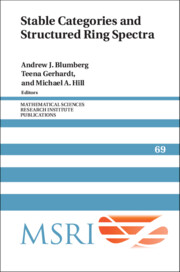Book contents
- Frontmatter
- Contents
- Contributors
- 1 Introduction
- 2 Homotopical categories: from model categories to (∞, 1)-categories
- 3 Stable categories and spectra via model categories
- 4 Stable homotopy theory via ∞-categories
- 5 Operads and operadic algebras in homotopy theory
- 6 Commutative ring spectra
- 7 An introduction to Bousfield localization
- 8 Spectral algebraic geometry
- Bibliography
- Index
3 - Stable categories and spectra via model categories
Published online by Cambridge University Press: 29 May 2025
- Frontmatter
- Contents
- Contributors
- 1 Introduction
- 2 Homotopical categories: from model categories to (∞, 1)-categories
- 3 Stable categories and spectra via model categories
- 4 Stable homotopy theory via ∞-categories
- 5 Operads and operadic algebras in homotopy theory
- 6 Commutative ring spectra
- 7 An introduction to Bousfield localization
- 8 Spectral algebraic geometry
- Bibliography
- Index
Summary
The first popular model category of spectra was due to Bousfield–Friedlander [56], and for many years it was the only one in common use (a previous model due to K. Brown [61] never really caught on). But this category does not admit a suitable smash product on the model category level. Following an early but limited attempt by Robinson [248], in the late 1990s several new model categories of spectra appeared that fixed this problem. These days a working topologist should know a little about each of these models, and about their various advantages and disadvantages.
Here is a list of the main players:
(1) Bousfield–Friedlander spectra
(2) Symmetric spectra
(3) Orthogonal spectra
(4) EKMM spectra
(5) Γ-spaces (which only model connective spectra)
(6) 𝑊-spaces (generalizing “functors with smash product”)
While it would be nice to pick out one model and say this is the one everyone should learn, life is not that simple. An algebraic topologist is likely to encounter each of the above models at some point, and some will have advantages over others depending on the context. For example, at this point there is a developing consensus that orthogonal spectra work best for equivariant homotopy theory; but some constructions — like Waldhausen K-theory — naturally produce a symmetric spectrum, not an orthogonal one. Functors with smash product (FSPs) have largely disappeared from the stage, being eclipsed by (2) and (3), but they are still worth a passing familiarity. In this survey we concentrate on (1)–(4), with (5) and (6) only making a quick appearance at the end.
To describe the organization of this survey, it is helpful to use an analogy from daily life: the automobile. For most of us, an automobile is a box with wheels that has certain behaviors when we turn the steering wheel or step on the pedals. That very primitive level of understanding is sufficient for most day-to-day functioning, and it is rare that any of us have to actually look under the hood. To some extent, the same holds true of spectra. Much of daily life can be covered just by knowing that there exists a model category of spectra with a smash product satisfying a small list of basic properties. This kind of superficial knowledge is fine for driving around town, but unlike the automobile analogy my experience has been that nearly every trip on the homotopy-theory highway requires one or two stops to mess around with the engine. It bothers me that this is so, and I usually find myself cursing at the injustice when I have to do it, but this seems to be the nature of the subject.
Information
- Type
- Chapter
- Information
- Stable Categories and Structured Ring Spectra , pp. 75 - 150Publisher: Cambridge University PressPrint publication year: 2022
